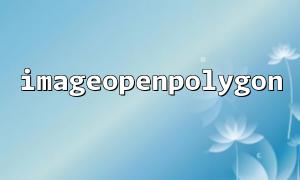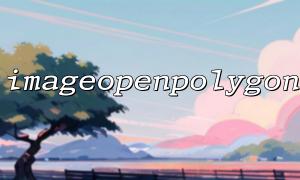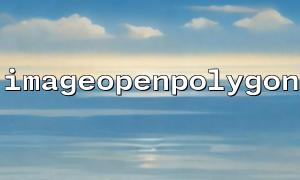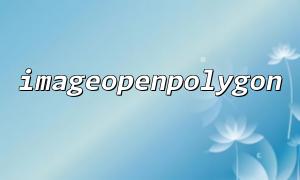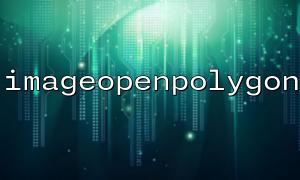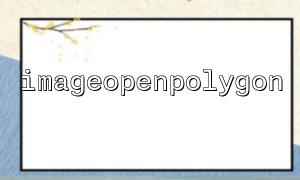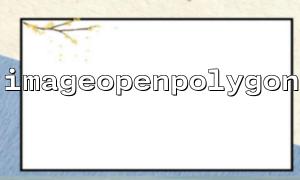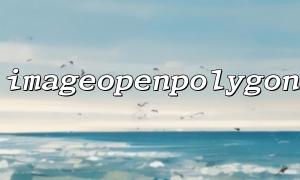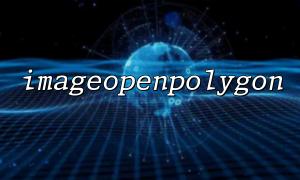The imageopenpolygon() function is a useful tool for drawing polygons when drawing graphs using PHP's GD library. However, developers may encounter the problem that it "does not take effect" when using this function, which is confusing. This article will describe how to troubleshoot and resolve this problem so that you can better use this function in PHP drawings.
Before starting to troubleshoot problems, first understand the basic usage of the imageopenpolygon() function. This function is used to draw a polygon in the given image. The syntax is as follows:
bool imageopenpolygon ( resource $image , array $points , int $num_points )
$image : Target image resource
$points : an array containing the coordinates of each vertex of a polygon, in the form of a two-dimensional array
$num_points : The number of vertices
The return value of this function is a Boolean value, true means the drawing is successful, and false means the failure.
The imageopenpolygon() function requires you to pass in a valid image resource. If the image resource is empty or not created correctly, the drawing operation will not be performed. Make sure you have successfully created the image resource before calling imageopenpolygon() , and you usually create images using functions such as imagecreate() or imagecreatefromjpeg() .
$image = imagecreate(200, 200);
$white = imagecolorallocate($image, 255, 255, 255); // White background
The $points parameter is a two-dimensional array containing the coordinates of each vertex of the polygon. Make sure that you pass in valid coordinate data and that the array is in the correct format. For example, an array of vertex coordinates should be like:
$points = array(
50, 50, // The first vertex
150, 50, // The second vertex
150, 150,// The third vertex
50, 150 // The fourth vertex
);
Each vertex is represented by two values, the first is the x coordinate and the second is the y coordinate. Make sure that the order and data type of each pair of coordinates are correct.
imageopenpolygon() requires at least 3 vertices to draw the polygon. If the number of incoming vertices is less than 3, the function will not be executed. So make sure the incoming $num_points parameter is consistent with the actual number of vertices.
$num_points = count($points) / 2; // Calculate the number of vertices
Before drawing the polygon, make sure that the image has been assigned color and that the color resources have been created correctly. For example:
$color = imagecolorallocate($image, 0, 0, 255); // blue
If the image is not assigned a color or the color is assigned an error, the graphics will not be displayed.
Ensure that the image output format is compatible with the drawing operation. The PHP GD library supports generating images in various formats such as JPEG and PNG. If you choose the wrong image output format, it may cause graphics drawing to fail.
For example, when outputting an image using header('Content-Type: image/png');, make sure that the image format matches the output format.
imagepng($image);
If the graphics do not display correctly, you can help analyze the problem by outputting debug information. For example, check whether the image resource was successfully created, whether the color was assigned correctly, and whether the vertex array was correctly passed in.
if (!$image) {
die('Unable to create image resources');
}
if (!isset($points) || count($points) < 6) {
die('Vertex array format is incorrect');
}
Sometimes complex code can mask the problem, and it is recommended to simplify the code for testing. For example, use the simplest polygon drawing:
$points = array(50, 50, 150, 50, 150, 150, 50, 150);
$num_points = 4; // Four vertices
Debugging with simplified code can help you determine whether there are any code logic problems.
Sometimes, the problem may be with the PHP configuration. To check whether the GD library is installed and enabled correctly, you can use phpinfo() to check the relevant information of the GD library. If the GD library is not enabled, you can refer to the official PHP documentation to install and enable the GD library.
phpinfo(); // Check GD Library configuration
The drawing problems of the imageopenpolygon() function may stem from multiple factors, including improper image resource creation, erroneous format of vertex arrays, unassigned colors, etc. These issues can often be solved by step-by-step troubleshooting and optimizing the code. I hope the troubleshooting methods and techniques provided in this article can help you solve drawing problems smoothly and make PHP's image processing function more powerful.
